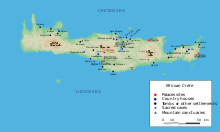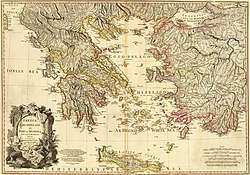
Back Minoïese beskawing Afrikaans حضارة مينوسية Arabic حضاره مينونيه ARZ Civilización minoica AST Minoy sivilizasiyası Azerbaijani Мінойская цывілізацыя Byelorussian Мінойская цывілізацыя BE-X-OLD Минойска цивилизация Bulgarian মিনোয়ান সভ্যতা Bengali/Bangla Minojska civilizacija BS
 | |
| Geographical range | Crete, additional settlements around Aegean Sea |
|---|---|
| Period | Aegean Bronze Age |
| Dates | c. 3100 – c. 1100 BC |
| Major sites | Knossos, Phaistos, Hagia Triada, Malia, Zakros |
| Preceded by | Neolithic Crete |
| Followed by | Mycenaean Greece |
| History of Greece |
|---|
 |
|
|
The Minoan civilization was a Bronze Age culture which was centered on the island of Crete. Known for its monumental architecture and energetic art, it is often regarded as the first civilization in Europe. The ruins of the Minoan palaces at Knossos and Phaistos are popular tourist attractions.
The Minoan civilization developed from the local Neolithic culture around 3100 BC, with complex urban settlements beginning around 2000 BC. After c. 1450 BC, they came under the cultural and perhaps political domination of the mainland Mycenaean Greeks, forming a hybrid culture which lasted until around 1100 BC.
Minoan art included elaborately decorated pottery, seals, figurines, and colorful frescoes. Typical subjects include nature and ritual. Minoan art is often described as having a fantastical or ecstatic quality, with figures rendered in a manner suggesting motion.
Little is known about the structure of Minoan society. Minoan art contains no unambiguous depiction of a monarch, and textual evidence suggests they may have had some other form of governance. Likewise, it is not clear whether there was ever a unified Minoan state. Religious practices included worship at peak sanctuaries and sacred caves, but nothing is certain regarding their pantheon. The Minoans constructed enormous labyrinthine buildings which their initial excavators labeled Minoan palaces. Subsequent research has shown that they served a variety of religious and economic purposes rather than being royal residences, though their exact role in Minoan society is a matter of continuing debate.
The Minoans traded extensively, exporting agricultural products and luxury crafts in exchange for raw metals which were difficult to obtain on Crete. Through traders and artisans, their cultural influence reached beyond Crete to the Aegean and eastern Mediterranean. Minoan craftsmen were employed by foreign elites, for instance to paint frescoes at Avaris in Egypt.
The Minoans developed two writing systems known as Cretan hieroglyphs and Linear A. Because neither script has been fully deciphered, the identity of the Minoan language is unknown. Based on what is known, the language is regarded as unlikely to belong to a well-attested language family such as Indo-European or Semitic. After 1450 BC, a modified version of Linear A known as Linear B was used to write Mycenaean Greek, which had become the language of administration on Crete. The Eteocretan language attested in a few post-Bronze Age inscriptions may be a descendant of the Minoan language.
Largely forgotten after the Late Bronze Age collapse, the Minoan civilization was rediscovered in the early twentieth century through archaeological excavation. The term "Minoan" was coined by Arthur Evans, who excavated at Knossos and recognized it as culturally distinct from the mainland Mycenaean culture. Soon after, Federico Halbherr and Luigi Pernier excavated the Palace of Phaistos and the nearby settlement of Hagia Triada. A major breakthrough occurred in 1952, when Michael Ventris deciphered Linear B, drawing on earlier work by Alice Kober. This decipherment unlocked a crucial source of information on the economics and social organization in the final year of the palace. Minoan sites continue to be excavated, recent discoveries including the necropolis at Armeni and the harbour town of Kommos.
© MMXXIII Rich X Search. We shall prevail. All rights reserved. Rich X Search